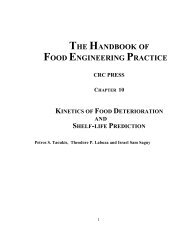A combined discreteâcontinuous model describing the lag phase of ...
A combined discreteâcontinuous model describing the lag phase of ...
A combined discreteâcontinuous model describing the lag phase of ...
You also want an ePaper? Increase the reach of your titles
YUMPU automatically turns print PDFs into web optimized ePapers that Google loves.
R.C. McKellar, K. Knight / International Journal <strong>of</strong> Food Microbiology 54 (2000) 171 –180 179<br />
<strong>the</strong> control <strong>of</strong> <strong>the</strong> S.D.<br />
L<br />
parameter. An example <strong>of</strong> possibility that some cells do not grow has not been<br />
this is evident in Fig. 6; <strong>the</strong> Gompertz function fit to considered. Thus <strong>the</strong> S.D.<br />
L<br />
must be considered an<br />
a discrete–continuous <strong>model</strong> simulation shows sys- estimate <strong>of</strong> <strong>the</strong> value for single cell variability. In<br />
tematic deviations. Systematic differences between l spite <strong>of</strong> this limitation, <strong>the</strong> discrete–continuous<br />
predicted by several <strong>model</strong>s including <strong>the</strong> three- <strong>model</strong> based on estimated tL<br />
and S.D.<br />
L<br />
values gives<br />
<strong>phase</strong> linear <strong>model</strong> <strong>of</strong> Buchanan and <strong>the</strong> Baranyi a good fit to <strong>the</strong> experimental data. More accurate<br />
<strong>model</strong> have been reported (Buchanan et al., 1997). estimates <strong>of</strong> single cell variance might be obtained<br />
These observations may even suggest that once using improved methods <strong>of</strong> single cell analysis (e.g.,<br />
individual cell behavior can be <strong>model</strong>ed accurately, microscopy).<br />
<strong>the</strong> traditional concept <strong>of</strong> population <strong>lag</strong> (l) as a<br />
<strong>model</strong>ing parameter will be <strong>of</strong> limited fur<strong>the</strong>r value<br />
to predictive microbiology.<br />
It is difficult to compare <strong>the</strong> discrete–continuous<br />
Acknowledgements<br />
<strong>model</strong> with <strong>the</strong> Baranyi <strong>model</strong> since <strong>the</strong> latter does The authors would like to thank J. Baranyi for<br />
not include a parameter <strong>describing</strong> <strong>the</strong> influence <strong>of</strong> helpful criticism <strong>of</strong> <strong>the</strong> manuscript.<br />
variation in tL<br />
on l. Baranyi (1998) has suggested<br />
that <strong>the</strong> mean population <strong>lag</strong> [l(N)] increases with<br />
lower inoculum, assuming tL<br />
values are exponentially<br />
distributed. In <strong>the</strong> present study a normal distribution<br />
References<br />
was assumed for t<br />
L, and with that <strong>the</strong>re was<br />
no evidence to support an increased t at lower Baranyi, J., 1997. Simple is good as long as it is enough. Food<br />
L<br />
Microbiol. 14, 189–192.<br />
inocula using ei<strong>the</strong>r simulations or experimental Baranyi, J., 1998. Comparison <strong>of</strong> stochastic and deterministic<br />
results. Additional simulations using exponential concepts <strong>of</strong> bacterial <strong>lag</strong>. J. Theor. Biol. 192, 403–408.<br />
ra<strong>the</strong>r than normal distributions for tL<br />
resulted in Baranyi, J., Pin, C., 1999. Estimating bacterial growth parameters<br />
predictions in which t values deviated from linearid<br />
by means <strong>of</strong> detection times. Appl. Environ. Microbiol. 65,<br />
ty, and changed depending on <strong>the</strong> random number 732–736.<br />
Baranyi, J., Roberts, T.A., 1994. A dynamic approach to predictseed.<br />
These simulations support <strong>the</strong> suggestion that ing bacterial growth in food. Int. J. Food Microbiol. 23,<br />
tL<br />
values are normally distributed. Fur<strong>the</strong>r experi- 277–294.<br />
ments are required to establish <strong>the</strong> correct distribu- Baranyi, J., Roberts, T.A., 1995. Ma<strong>the</strong>matics <strong>of</strong> predictive food<br />
tion.<br />
microbiology. Int. J. Food Microbiol. 26, 199–218.<br />
It must be emphasized that while <strong>the</strong> t decreases Breand, S., Fardel, G., Flandrois, J.P., Rosso, L., Tomassone, R.,<br />
d<br />
1997. A <strong>model</strong> <strong>describing</strong> <strong>the</strong> relationship between <strong>lag</strong> time<br />
with increasing cell number, <strong>the</strong> tL<br />
remains constant and mild temperature increase duration. Int. J. Food Microbiol.<br />
(Fig. 1). Similarly, S.D.<br />
L<br />
is constant, and <strong>the</strong> appar- 38, 157–167.<br />
ent decrease in variability between wells with in- Buchanan, R.L., Whiting, R.C., Damert, W.C., 1997. When is<br />
creasing cell numbers per well is a consequence <strong>of</strong> simple good enough: a comparison <strong>of</strong> <strong>the</strong> Gompertz, Baranyi,<br />
<strong>the</strong> majority <strong>of</strong> <strong>the</strong> cells having a t close to <strong>the</strong> and three-<strong>phase</strong> linear <strong>model</strong>s for fitting bacterial growth<br />
L<br />
curves. Food Microbiol. 14, 313–326.<br />
mean. As numbers <strong>of</strong> cells per well increase, <strong>the</strong> Chorin, E., Thuault, D., Cleret, J.J., Bourgeois, C.M., 1997.<br />
observed td<br />
for each well becomes less dependent on Modelling Bacillus cereus growth. Int. J. Food Microbiol. 38,<br />
<strong>the</strong> td<br />
for individual cells, and starts to reflect <strong>the</strong> 229–234.<br />
mean t value.<br />
Cuppers, H.G.A.M., Smelt, J.P.P.M., 1993. Time to turbidity<br />
d<br />
There are some limitations to <strong>the</strong> use <strong>of</strong> <strong>the</strong> measurement as a tool for <strong>model</strong>ing spoi<strong>lag</strong>e by Lactobacillus.<br />
J. Ind. Microbiol. 12, 168–171.<br />
Bioscreen for indirectly estimating single cell be- Dalgaard, P., Ross, T., Kamperman, L., Neumeyer, K., McMeekin,<br />
havior. It is difficult to clearly identify <strong>the</strong> dilution T.A., 1994. Estimation <strong>of</strong> bacterial growth rates from turcorresponding<br />
to single cells; it is assumed to be <strong>the</strong> bidimetric and viable count data. Int. J. Food Microbiol. 23,<br />
dilution giving <strong>the</strong> greatest average t . In addition, 391–404.<br />
d<br />
assuming that cells follow a Poisson distribution, Garthright, W.E., 1991. Refinements in <strong>the</strong> prediction <strong>of</strong> microbial<br />
growth curves. Food Microbiol. 8, 239–248.<br />
some wells which are assumed to have single cells Garthright, W.E., 1997. The three-<strong>phase</strong> linear <strong>model</strong> <strong>of</strong> bacterial<br />
might have two or more cells. Wells which show no growth: a response. Food Microbiol. 14, 193–195.<br />
growth are assumed to have no cells; however, <strong>the</strong> Gibson, A.M., Bratchell, N., Roberts, T.A., 1988. Predicting














